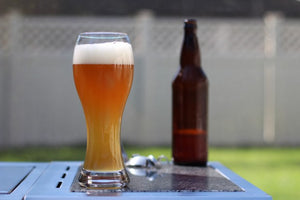Cullen's Witbier
BJCP Guidelines Category 16 A
Maltose Falcons Style Guidelines Category 22.1
I have been brewing Witbiers for a number of years now with very good results, drawing gold regularly in competition. This style can be hard to hit right on because it’s a game of subtlety. It has to be phenolic, but not overly so, ever so slightly tangy, just a gentle suggestion of spiciness, hazy but not murky, generously carbonated but not so much you get all head. The un-subtle parts: very crisp, very refreshing and very delicious!
From what I've read, the malt bill should contain up to 50% (+/- 10%) un-malted (Torreified) wheat, rather than malted wheat, with the rest being (probably Belgian) Pilsener malt and maybe a few oats. The un-malted wheat (with other light grain) is what gives you that hazy, straw-colored, puffy- headed classic Wit look. I’ve known other brewers of good witbier who used wheat flour instead of whole grain. Unfortunately, the grain bill makes it night impossible to create an extract version true to style. One could approximate with wheat malt extract, but it’s not the same. Make a Hefeweizen instead. One might worry about stuck mash with all that wheat, but I have never had a problem there. Just run off slowly if you're worried about it. One should probably start the mash low and step up, to give it some opportunity to have a little proteolytic action early on. Also, I’ve read that a thin mash tends to favor proteolytic action. I have heard of some wit brewers starting a mash in the mid 90’s Farenheit. I have taken to stepping up with mini-decoctions, mostly so I can use two burners on my stove instead of having to wait of one to do the work.
One should go easy on the spice additions. I use about .25 oz of crushed (not ground) coriander seed and the same amount of dried Curaçao orange peel at the very end of the boil. Use a less estery Belgian yeast strain. The fruity, spicy, floral pungent aromas from many strains are awkward in a witbier. I like White labs WLP400 or Wyeast 3944 (both are wit ale strains), which have given me a clean aroma with just a whiff of phenol, allowing the spicing to show up and add to the complexity, instead of fighting for recognition. I know that this beer can be a bit more trouble to make than say, a basic bitter, but it's a very richly rewarding, full-flavored refresher, and well worth the trouble. You can find one of my Wit recipes (I experimentally swapped oats for rye), Artemis Callipygia Witbier on our club website.

